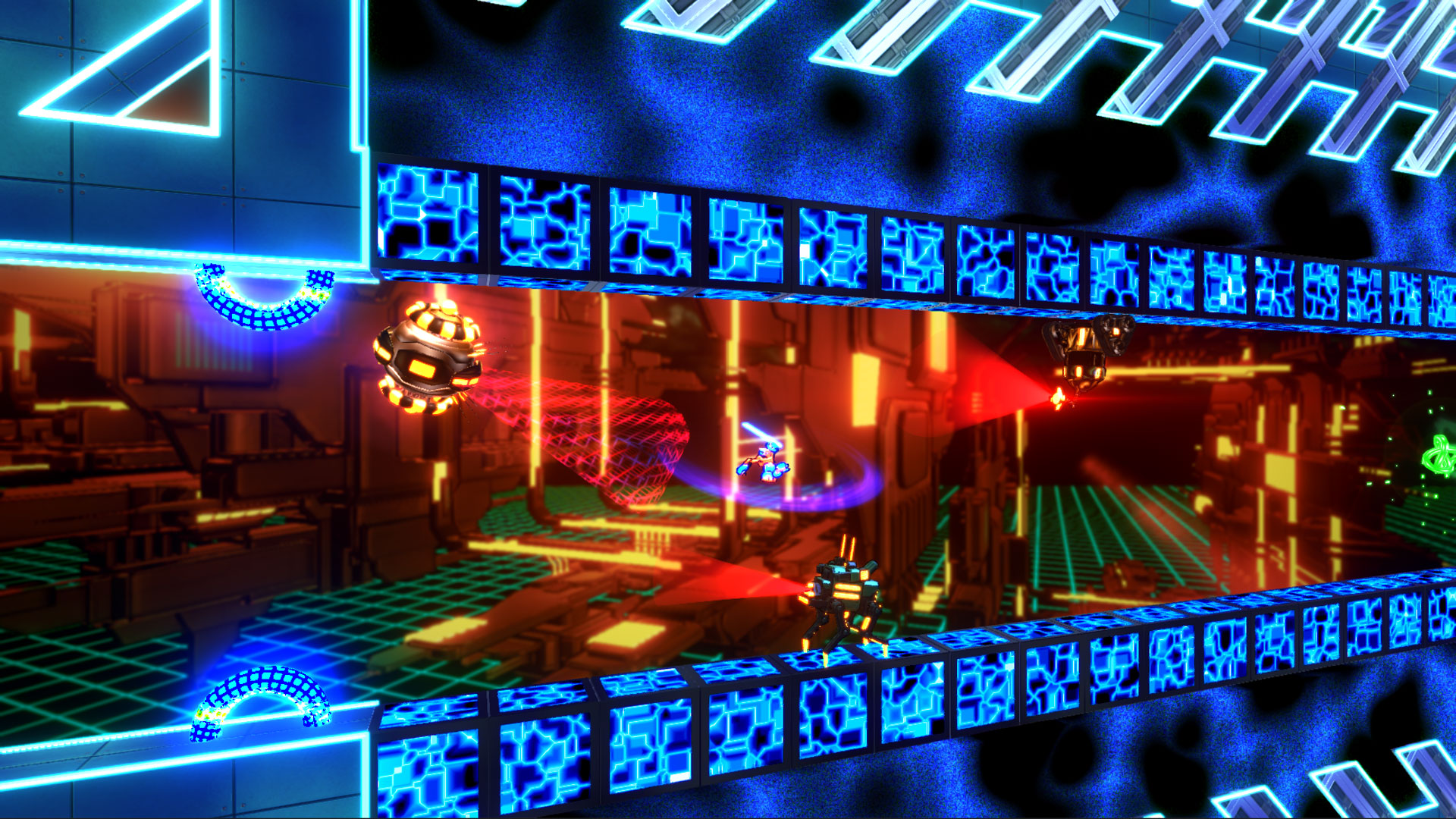Platformers easily rank among my favorite genres. There’s little concern about convoluted mechanics and a lot of emphasis on design and overall fun. Part of the appeal to me is that I don’t need long winded tutorials to understand what I should be doing. I can just jump into the game and jump IN the game while making my way from point A to point B.
Perhaps that’s why I found a lot of fun in the simplicity of Exception. Even with the clever twists it adds to the formula, it still plays and feels like a platformer.
Developer: Traxmaster Software
Publisher: Traxmaster Software
Platform: Nintendo Switch
Release date: Aug 13, 2019
Price: $14.99
Exception is a 2D platformer located in a rotating 3D world. You play as one of many thread in a computer system, tasked with fixing whatever crisis was caused by alice34 and the virus she just downloaded.
Quoting the developer Will Traxler:
“Exception traces its roots back to the original NES and the simple, uncomplicated fun of running around and smacking stuff with a sword.”
A unique “Twist”
The main mechanic of Exception is the transformation the levels undergo. By colliding with one of the green/blue symbols, the level will transform. These transformations can take the shape of level rotations in any of the 3 axis, or more complex transformations.

In theory, these transformations are a nice way to showcase that previously harmless elements of a stage can become dangerous under the right circumstances. You probably don’t think much of the electric trap on the ceiling until the level rotates and it becomes the floor. It also works as a self-solving puzzle in a way as you see the goal in the distance, but only becomes reachable after certain transformations.
The trick under the hood
The reality is that I found most transformations to be pointless and disorienting. For the most part, there is an element of uncertainty as to what the next transformation is going to be. You won’t know where it will rotate or how will it transform. This takes away a possible feeling of magic or that eureka moment where you use transformations to your advantage. Instead, you just go through the level and trigger all of them because, you pretty much have to anyway. With very few exceptions, most transformations could just take you to entirely new sections and the gameplay would be exactly the same.
Keeping up with the uncertainty of the transformations, it’s hard to know what to do afterwards. A rotation could put a wall in front of you. It could also put an enemy or trap. To be fair to the game, in most scenarios you can just keep doing whatever you were doing before. For example, if you were jumping to the right when you touched the transformation, there’s probably going to be either a path to the right, or a wall which you must wall jump to reverse your direction.
No exceptions to your movement
Controlling your thread is an all too familiar affair for the better. You can run and jump like most platformers. You can also wall jump to reach higher ground or slide to pass through narrow passages. By holding down, you can wall jump downwards to travel faster.
Combat is a little bit different because most combat options are unlocked by progressing through the game. By pressing the Y button, you can swing your trusty sword to destroy enemies. Most of them die in one hit and there’s pretty much no downside to swinging wildly.

Progressing through the game will allow you to unlock additional moves. Even though there are 6 unlockable moves, it actually boils down to 3: sword throw, down kick and up round slash. If you wonder what the other 3 are, it’s just additional ways of throwing your sword: Air throw, down air throw and up air throw. Out of all the bunch, I found the divekick and the air throw to be the most useful, as one allows me to pogo from enemies, while the other is the offensive move of choice to deal damage while staying mobile.
Boost mode
By pressing ZR you can enter boost mode. While in this mode, you create colorful after images behind your movement and also move faster.
Boost mode causes me a lot of regrets because I don’t think it is mentioned at any point during the “tutorial” levels. Wanna know when I found out I could boost? Right after I 100%’d the entire game and was browsing the many game options to see if there was anything else. No wonder I had a very hard time collecting the byte in 4.4, I probably did some hardcore sequence break that wasn’t intended to collect that one.
Powering up
As I mentioned, some of your abilities are unlocked as you progress the game. Think of it as a level up system. Instead of exp, you collect stars from performing well on a level. Acquire enough of these stars, and you will level up which unlocks a new move. Performing better on the levels will net you more stars, which accelerate the rate at which you acquire new moves.
Scattered throughout each level is one collectible item called a “byte”. These bytes allow you to further upgrade these unlockable abilities. Each ability can have its speed or range upgraded up to 6 levels.

Very easy to digest
One of the things that Exception has going for it is that it is a very easy game to digest. At any given time you can just jump in and beat a few levels. In each of these levels you can go as fast as possible to achieve a 4 star ranking or collect the byte, maybe even both. It never feels cumbersome or a hassle, retrying is fast and snappy and the game offers very little downtime from the action.
One of the aspects of a game which I found to be very underrated is being given clear goals. In Exception, each world has 8 levels. In each of the levels you can earn 1-4 stars based on your end time and a byte. The game presents the list of levels, along the highest number of stars achieved and if the byte was collected or not.
Note: During my playthrough, I found the star rating to be bugged. The number of stars it presents to you at the end of the level, shows the amount of stars you earned without bonuses but the game does consider bonuses internally. This means that if the 4 star threshold was 20 secs, but you had 20.5 and a -1.5 slasher bonus, then the game will display 3 stars even though your bonus puts you at 19.0, which earns the 4 star award. The star ranking is shown correctly on the level select screen, so ignore whatever star rating the game shows you and just look to see if your adjusted time is lower than the 4 star threshold.
This presentation makes it very easy to see if you have everything you need in a world, and if you do, you get a 110% completion rate. In many happy ways, it reminds me how rewarding it felt to check the pause screen on Mario 64 and seeing the worlds with all the starts filled out. I know when I have achieved everything I needed to achieve, and that is awesome!

Faulty mechanics
With everything that exception has going for it, it also fails at the element that mattered the most: mechanics. It’s hard to accurately put everything that isn’t working as expected, but I’ll try my best.
I am a speedrunner, so I’m very adept at recognizing movement tech and abusing it to my advantage. The biggest issue I found with exception is that the game tends to eat your inputs when it skips frames. This is a mild issue on docked mode, as the runs considerably smoother. It is on handheld that it becomes a nightmare. The framerate is very low and as a result the movement feels like it has latency and your inputs have a delay to them, that is when they aren’t downright eaten by the game.
General movement feels sticker than it should be. Sometimes you will cling to the wall when you don’t want to. The wall will also slow you down if you attempt to wall jump in Mega Man X/Super Metroid fashion which is to say to press against the wall and push the opposite direction before jumping. In exception, to wall jump just jump towards the wall and press the jump button without inputting any direction whatsoever.
In the mild annoyances department, there is a small freeze when you kill an enemy. This freeze applies to you and the timer, but not for the rest of the level, which creates minor mayhem if you were planning ahead.
Nice presentation
Exception has a couple of things going on in the presentation department. Perhaps one of my favorites is how the background pixelizes when you take a hit, and the foreground pixelizes when you take two. Since you don’t have an HP counter on the UI, this is your way of knowing how much HP you have left. I think it looks very cool, although the fully pixelized screen is slightly blurry and gives me a headache.

The soundtrack is purely synthwave and has a hefty amount of tracks. It does a lot to amplify the “threads in the system” motif and also enhances the tron-ish aesthethic.
Finally, the story. I found it very funny how the history presents itself in the beginning from the computer of granny and how she has a bunch of toolbars installed on her browser. There are a lot of tongue-in-cheek details throughout the whole story that you might miss if you aren’t paying attention. I’ve read reviewers calling the story bland, and while I do agree that it is for the most part very inconsequential, I encourage you to play it all the way to the end. Once you put all the pieces together, the story becomes a lot more memorable, trust me on this one.
Final words
Oh boy, giving a veredict for this game is very hard for me. For the most part, the faults in the mechanics and casual irresponsiveness left me mildly infuriated at times. On the other hand, I did spend close to 10 hours on this game and went full completionist with it.
In the end, there is one thing which is more important than anything, and that’s that I had fun. While there’s many places in which this game could improve, the end result is a purchase that I don’t regret as I had fun while playing it akin to Super Meat Boy.

